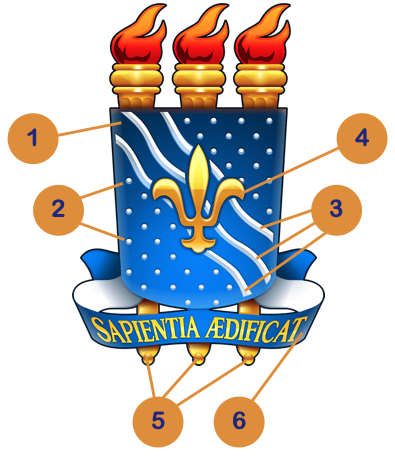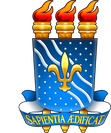Coat of Arms

As a Coat of Arms, UFPB's crest blazons symbols that depict the history, geography, and traditions of the state of Paraíba. Ernst "Paulo" Lachenmayer, a heraldist born in 1903 at Langenargen, Germany, designed it with an escutcheon, several emblems, and a motto authored by Professor Afonso Pereira. Brother Lachenmayer served as a monk until his passing in 1990 at the São Bento Monastery, in the city of Salvador, capital of the state of Bahia.
Round-shaped at the bottom, the Portuguese-style escutcheon clusters all the elements that form the crest. See below a short description of each of them.
1. Field: colored in azure (blue), argent (silver), and (gold) tinctures, it is composed of bezants scattered around three wavy bendlets superposed by a central fleur-de-lis.
2. Bezants: the circles in silver over the blue field refer to a miracle worked by Our Lady of the Snows ("Nossa Senhora das Neves", in Portuguese), patron saint of the state of Paraíba. Word has it that the saint brought a snowfall over a mountain in the European summertime to indicate where to build a basilica. Thus, the bezants symbolize snowflakes.
3. Wavy bendlets: the bendlets depict the meanders of the North Paraíba River over three hydrographic regions: Higher Paraíba, covering the Cariri Region and Serra Jabitacá, where its source springs up; Mid Paraíba, extending over the Serra da Borborema's slopes; and Lower Paraíba, ranging from the Curimataú Region to its estuary, in the Atlantic Ocean.
4. Fleur-de-lis: denotes the purity and richness of the human knowledge reached through higher education.
5. Insignias: three flaming golden torches represent teaching, research, and extension, three key elements since the university's inception.
6. Motto: printed in gold on a blue banderole, the Latin expression SAPIENTIA ÆDIFICAT ("Wisdom Builds") refers to the benefits of knowledge in educating people and building societies. The motto was inspired by an early inscription carved on the façade of the old Humanities Course building, the former headquarters of the Law School.
